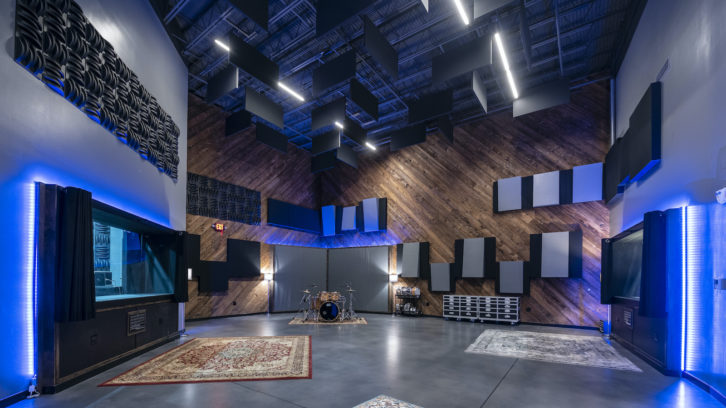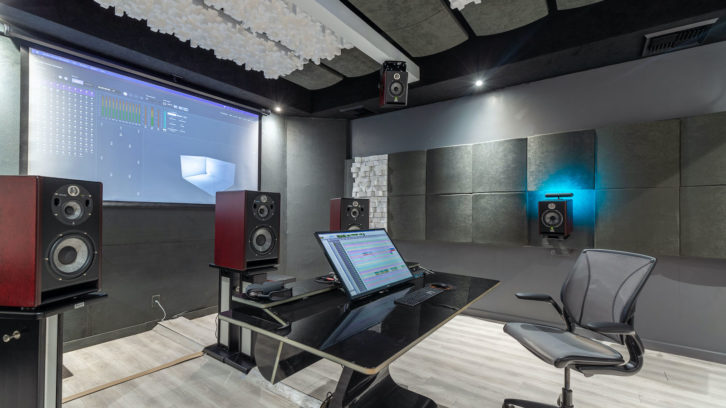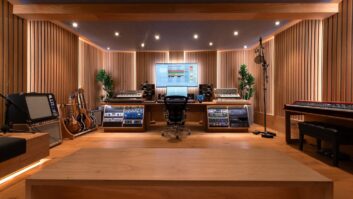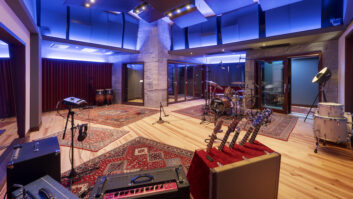
With the Studio Class of 2022, Mix is proud to showcase 18 exciting new creative spaces from some of the best studio designers and acousticians in the business. This year’s “Class” of new or redesigned studios includes everything from beautifully realized personal studios (like the one on this month’s cover) to audio education institutions, sound-for-picture facilities, commercial complexes and mastering rooms. Most importantly, each of the studios is uniquely matched to the needs of its owner, realized with the help of a professional design team.

Rambling Rose — Parker, Texas
When musician/songwriter Matt Boggs was getting ready to build a brand-new family home, he decided to make a new studio part of the design process. The artist wanted to create a space where he could write and his touring band, Prophets and Outlaws, could rehearse and record. At the same time, he wanted to maximize at-home time with his growing family. He sought out Russ Berger’s firm, Russ Berger Design Group, to design a flexible studio.
“Russ got to know me and how I would use the space,” Boggs recalls. “Sometimes I was just going to be a writer in the studio, but there’s five of us in our band, and when we rehearse, we like to all play at the same time, and that was going to require a certain amount of square footage.” Berger came up with a plan that included a control room and tracking room that are separated by a folding glass wall. Boggs can make use of two separate rooms, or he can open the panels and enjoy a single 900-square-foot space.
“That arrangement was a factor in terms of how we treated each area,” Berger says. “When you open the panels and it becomes a coupled space, you’re borrowing volume from one space into the other, and it affects the character of the sound—the low-frequency energy that might build up. And you must remember, you’re talking about a whole band playing all at once in a room, and in a small, confined space, levels can become almost dangerous without proper treatment. So, in the tracking area, we aimed for a neutral environment, something that still has a nice natural character in the room. but it’s a little more on the dry side so that it would work well for rehearsal.”
Adding to the flexibility of the recording space is the implementation of Berger’s proprietary pArtScience SpaceInerator, an electronic system that can transform the room’s acoustics.
“It allows you to go into this dry space, punch a button, and make it sound like a small club. Punch another button and make it sound like a concert hall, or a cathedral, or a small church— almost any kind of environment you can think of,” Berger says. “It’s electronic architecture. You’re able to control the ambient character of the space in real time. It can be as if the ceiling were raised 20 feet, the side wall was moved out 30 feet, and the back wall was moved out 40 feet.”
A Chat With Russ Berger
Berger also paid special attention to isolation, as the studio is connected to Boggs’ family home.
“It has a stone masonry exterior and layers of engineered drywall on the inside—it’s a completely contained envelope. So, you can be wailing away in there and you don’t hear anything outside at all,” Berger observes. “When I first met Russ, I think we had one baby on the way, and now we have three kids,” Boggs says. “So we made sure the studio is also tucked into the side of the property. The structures share a roof, but there’s a breezeway in between; you have to go outside to get into the studio, and then through a heavy sound-rated door with a security code. So, I’m close to home, which is great, but a studio isn’t a safe environment for small children, and that was one of the important considerations.”
Berger also helped Boggs settle on his complement of studio equipment: a Rupert Neve Designs 5088 Shelford console, ATC SCM45A 2.1 monitors, Pro Tools HD Native system with Focusrite RedNet converters, and an array of instruments, outboard equipment, mics, and amps.
“I had a lot of fun working with Russ, and I learned a lot,” Boggs says. “It became an important part of my musical journey. There were so many aspects of the process that I never would have considered without Russ’ help. I came up on the musician side rather than the engineering or producing side, but the studio has been open seven months now, and I’ve already made big strides.
“The first thing we did here was to record a song I got to write with Paul Overstreet when I went on a songwriter trip with him a few years ago,” Boggs continues. “We’ve also recorded our band’s newest single, ‘Cowboys and Dreamers,’ which will be coming out soon. I’ve also had buddies over to do songwriting sessions; we’ll track songs and just jam. I’ve realized that one of the coolest things is that people can come over, and we can sit down and immediately start working. I’m always set up and ready to go.”

Fallen Trees Studio — Mt. Airy, N.C.
This ground-up facility was designed by Wes Lachot Design Group and acoustician Aaron Kelley to offer a controlled yet lively ambience, including a live front end in the control room that maintains the accuracy of the facility’s Guzauski-Swist GS3-B monitors by using reflection-freezone principles. Sightlines between all spaces ensure the beautiful forests of Mt. Airy are visible throughout the studio, which adds atmosphere whether the rooms are being used by owner Chad Barnard or by visiting professionals. Specialty acoustic treatments and installation were provided by Brett Acoustics, while cabling consulting was by Canova Audio. Howard Hoyt of Pro Audio Engineering was the electrical engineering consultant on this project. The studio is equipped with an API 1608-II console with API preamps and EQs, as well as a Pro Tools rig with 32 channels of UA Apollo converters.

MTSU — Murfreesboro, Tenn.
Designed by Peter Grueneisen of nonzero\architecture, with assistance from local architect of record Steve White of Bullock, Smith and Partners, this new studio is one of the latest additions to Middle Tennessee State University’s acclaimed Music and Recording Industry program. It is part of a new, nearly 5,000-square-foot complex that includes two identical control rooms and a variety of live rooms and booths. Pictured are the live room of Studio D and Control Room E, which are under a tall roof that allows for 17-foot ceilings in the tracking rooms. Studio D is the larger of the two studios, featuring a 22×27-foot main room, large and small isolation booths, and an amp closet. Studio E has a more modest 16×20 main studio, one iso booth and an amp closet. With system design by MTSU, Mike Rhodes and SkinnyFish Audio, both studios feature SSL AWS924 consoles, Avid Pro Tools DAWs, and audio monitoring by ADAM Audio and Phantom Focus, tuned by Carl Tatz. Also on-hand is a selection of outboard gear from API, Bricasti, Chandler Limited, Universal Audio and others.

Atrium Audio — Lititz, Pa.
Atrium Audio was designed by Jeff Hedback of HDAcoustics for Grammy-nominated producers Carson Slovak and Grant McFarland. The project comprises a 3,500-squarefoot facility, where control rooms A, B and C all have direct sightlines to the large live room. The mirrored control rooms A and B both have dedicated overdub booths. The fourth control room is 7.1.4 Dolby Atmos Music-certified.” Room modeling and shape optimization studies were performed using the acoustical software from Olive Tree Labs and CATT-Acoustics. Control rooms A and B feature all custom acoustic treatments, while other spaces have some custom treatments, as well as products from GIK Acoustics, Primacoustic and Acoustimac. Specialty fabrication/construction was performed by Jerod Ecenrode, while Zack Fagan provided technical wiring consultation and design. Selected equipment includes an SSL Origin console; Focal, Genelec, and JBL monitors; and a large collection of outboard gear and microphones from Neve, Grace Design, UA, TubeTech, Manley, Neumann, Shure and others.

The Church — Tulsa, Okla.
Steven Durr Designs exercised great care to restore The Church studio, honoring its historical significance as it is listed on the National Register of Historic Places. Such a prized designation came with specific challenges due to stringent requirements to maintain the more than 100-year-old building’s design intent and 1970s studio aesthetics, while renovating and updating the facility to be relevant for today’s recording standards.” Collaborating with Chad Hailey Research and Lilly Architect, SDD helped facilitate an extensive remodel that merges modern technologies with the original vibe/ intention of the late Leon Russell when he converted the old church into a recording studio and office for Shelter Records in 1972. In addition, the tracking room doubles as a performance venue and has hosted intimate concerts by legacy artists such as Kenny Loggins, George Thorogood and Ann Wilson.”

Studio DMI — Las Vegas
Grammy-nominated engineer Luca Pretolesi’s 4,000-square-foot Studio DMI complex in Las Vegas includes four studios powered by Focal monitors, a production/recording room, artist lounge, conference room, and office space. Haverstick Designs redesigned Studio D (pictured), which is now a Spatial Audio/Dolby Atmos mix studio featuring custom bass trapping that integrates the existing treatment from Vicoustic to improve the low-frequency performance of the room. Additional elements were added to position the 7.1.4 Focal speaker system properly. Studio D also contains a Pro Tools MTRX Studio system. The renovation, implemented by contractor Paolo Dechierico, was completed in March 2022, with system design by Pretolesi and Joshua Estock from Focal.







